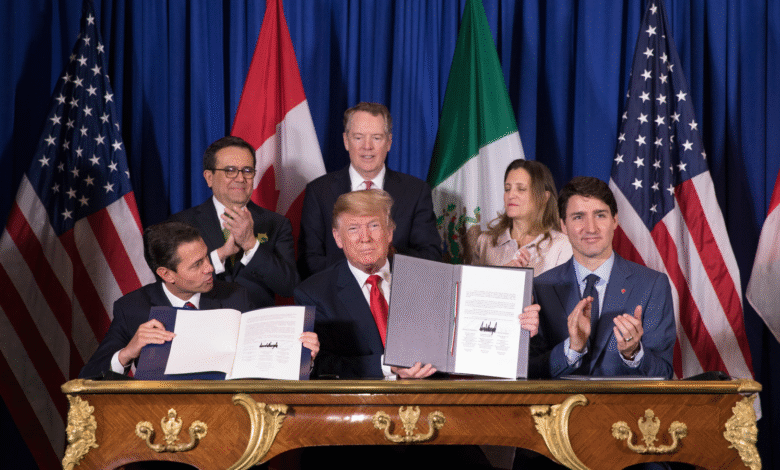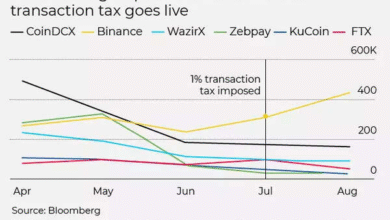Trump Trade Deals: Why He Says ‘We Don’t Have to Sign’

Trump trade deals have become a focal point of discussion, particularly as the business magnate and former president navigates the complexities of U.S. trade policy. In recent statements, Trump has downplayed the urgency of signing official agreements, asserting that countries need to negotiate with the U.S. rather than the other way around. This departure from traditional approaches to trade agreements has left many wondering about the future of tariff talks and the overall economic landscape. While the Trump administration has stirred anticipation with hints of potential bilateral trade discussions, no concrete frameworks have emerged. Investors are now left in a state of uncertainty, grappling with the implications of these stalled negotiations on the economic front.
The recent discourse surrounding Trump’s trade strategies highlights a significant shift in how the U.S. engages with international commerce. By emphasizing a less formal approach to international agreements, the former president signals a desire for a more assertive negotiating position in the global market. This evolving narrative on trade interactions underscores a broader discussion about U.S. trade relations and tariff policies that are crucial for maintaining competitive advantages. As anticipation builds regarding possible trade arrangements with various nations, the lack of definitive agreements raises questions about future economic stability and growth. These developments illustrate the intricate balance between diplomatic negotiations and economic realities in today’s fast-paced global economy.
Understanding Trump Trade Deals: A Shift in U.S. Trade Policy
President Trump has recently conveyed a notable shift in U.S. trade policy, suggesting that formal trade agreements may not be as critical as previously believed. During a meeting with key officials, he claimed that the United States is in a position of strength, asserting, “We don’t have to sign deals; they have to sign deals with us.” This perspective raises important questions about the future of U.S. trade strategies and how they may evolve under the Trump administration. The sentiment indicates a move away from proactive negotiation and could redefine the landscape of bilateral trade in coming months.
This shift has sparked considerable debate among economists and policymakers alike. Many are concerned that this approach could lead to an increase in tariffs and tensions with trading partners, particularly as ongoing tariff talks reflect the delicate balancing act needed to maintain healthy trade relationships. The lack of formal trade agreements could lead to decreased foreign investment and uncertainty in the markets, emphasizing the president’s assertion that trading partners are keen to secure favorable terms with the U.S. market. As the administration navigates these changes, the implications for future trade agreements are significant.
The Impact of Tariff Talks on Future Trade Agreements
Tariff talks have become a focal point of U.S. trade discussions, especially concerning the potential implications for future trade agreements. With President Trump downplaying the necessity of signing new deals, the importance of these negotiations hangs in the balance. The current environment of heightened tariffs not only affects market dynamics but also shapes how countries engage in trade discussions with the U.S. As tariff-related slowdowns begin to impact the economy, there is mounting pressure for clarity on future agreements.
The uncertainty surrounding negotiations, particularly with nations like Canada and Mexico, poses a challenge to the Trump administration’s trade objectives. As businesses and investors wait for definitive actions, the implications of ongoing tariff talks could very well dictate the pace at which the U.S. re-engages with its trading partners. Policymakers must carefully consider how these discussions align with broader economic goals and navigate the complexities of trade agreements that may arise from them.
Bilateral Trade Talks: Key Considerations for the Trump Administration
Bilateral trade talks have traditionally been a cornerstone of U.S. trade policy, yet the recent comments from President Trump signal a potential shift in how these discussions are approached. Rather than focusing on comprehensive trade agreements, there is a growing sentiment within the administration that emphasizes bilateral negotiations on a case-by-case basis. This approach allows for greater flexibility but also introduces uncertainties regarding commitments and enforceability, which could complicate relationships with other countries.
The Trump administration’s strategy suggests a reluctance to be bound by formal agreements, raising essential questions about the future of U.S. trade relationships. As officials continue to explore opportunities with countries such as India and Japan, the efficacy of this alternative approach will come under scrutiny. Balancing the economic interests of American markets while maintaining fruitful bilateral discussions is a challenge that the administration will need to address as it charts its path forward.
Economic Consequences of Downplaying Trade Deals
The decision to downplay trade deals could have significant economic ramifications for the United States. As uncertainty looms over potential agreements, investors react by pulling back, impacting market stability and overall confidence in the economy. The president’s refusal to prioritize trade agreements may lead to increased volatility as businesses grapple with the implications of ongoing tariff talks and unclear trade policies.
Moreover, without substantive trade agreements, the U.S. risks losing competitive advantages in international markets. The lack of commitment to formal deals might deter foreign investment and innovation, which are critical for long-term economic growth. In an increasingly interconnected global economy, the approach taken by the Trump administration could redefine America’s role and influence, raising stakes not just domestically but globally.
Future Trade Strategy: Balancing Tariff Talks and Agreements
As the Trump administration navigates the complexities of trade policy, finding the right balance between tariff talks and the pursuit of trade agreements will be crucial. The recent remarks from President Trump indicate a reluctance to engage deeply in negotiations, focusing instead on a strategy that plays up U.S. market strength. However, this may create a precarious situation for U.S. exporters and industries reliant on access to foreign markets, as trade tensions escalate.
To foster a more stable trade environment, the administration might need to reconsider its stance on the importance of formal trade agreements. Engaging in bilateral and multilateral talks could alleviate the uncertainties brought on by ongoing tariff discussions. By striking the right balance, U.S. policymakers can aim for a strategy that encourages growth while ensuring that American businesses remain competitive on the global stage.
The Dynamics of U.S. Trade Policy Under Trump
U.S. trade policy under President Trump has seen significant evolution, particularly in recent months. His administration has emphasized a more aggressive stance on tariffs while simultaneously expressing ambivalence towards signing new trade deals. This dual approach raises questions about how the U.S. will navigate its economic relationships moving forward. The emphasis on leveraging tariffs as negotiation tools has the potential to reshape global trade dynamics, especially with key partners in the Asia-Pacific region.
The departure from traditional trade policy models signifies a bold strategy that prioritizes American interests. However, as Trump administration officials grapple with the complexities of trade negotiations, they may find that a lack of formal agreements could lead to backlash from industries affected by increased tariffs and uncertain trade environments. The need for a coherent strategy that encompasses both tariff policies and trade agreements will be essential in maintaining economic stability and growth.
Investor Reactions to Uncertainty in Trade Agreements
Investors are closely monitoring the trade landscape, particularly in light of President Trump’s statements regarding the necessity of trade deals. The uncertainty stemming from the administration’s stance has led to increased anxiety in the markets, as investors fear that prolonged ambiguity could affect stock performance and overall economic stability. Without clear signals about upcoming trade agreements or resolution of tariff talks, market volatility could remain heightened for the foreseeable future.
The sensitive nature of trade relationships requires a well-communicated approach from the administration to restore investor confidence. As discussions about potential deals with countries like India and South Korea unfold, the clarity and direction on U.S. trade policy will be crucial for maintaining a favorable investment climate. Investors are waiting for definitive policies that can foster growth and mitigate risks associated with global trade dynamics.
The Role of Tariffs in the Trump Administration’s Trade Strategy
Tariffs have become a primary tool in the Trump administration’s trade strategy, serving both as a point of negotiation and a means to protect American industries. President Trump’s recent comments highlight a philosophy that centers on using tariffs to force foreign nations into favorable terms, rather than relying on traditional trade agreements. This method has sparked debates over its potential effectiveness and sustainability in the long run.
The administration’s reliance on tariffs may have significant implications for its relationships with trading partners. As countries respond to U.S. tariffs, the dynamics of international trade can shift, causing ripple effects in the global economy. The effectiveness of this approach will ultimately depend on its ability to yield concrete benefits for American workers and businesses while balancing the intrinsic risks associated with tariff escalations.
Exploring Long-Term Solutions for Trade Agreements
As the Trump administration wrestles with its trade strategies, the need for long-term solutions regarding trade agreements becomes apparent. While the president has advocated for a more laissez-faire approach to formal deals, the future of U.S. trade policy may ultimately hinge on the establishment of clear frameworks that facilitate smoother trade flows. Engaging with both traditional trade partners and emerging markets will be necessary to build a robust trade network.
Future trade agreements should be designed to be beneficial not just for the U.S. but also for its partners, fostering cooperative relationships that can lead to more stable economic interactions. It will be critical for the administration to cultivate an approach that encourages ongoing dialogue and collaboration, ensuring that U.S. interests are protected while also securing advantageous terms for all involved parties.
Frequently Asked Questions
What is the current status of Trump trade deals and tariff talks?
As of now, the Trump administration has downplayed the urgency of signing trade agreements. President Trump stated that the U.S. does not need to sign deals, suggesting that other countries are more keen to engage in bilateral trade talks. This stance reflects a shift in U.S. trade policy, moving away from previously anticipated agreements.
Why is the Trump administration prioritizing bilateral trade over formal trade agreements?
President Trump has indicated that the focus is shifting to bilateral trade discussions rather than formal trade agreements. He emphasized that countries want access to the U.S. market, which diminishes the immediate need for the U.S. to sign formal trade agreements as a priority in its trade strategy.
What impact do Trump’s comments on trade agreements have on U.S. markets?
Trump’s remarks regarding trade agreements have caused U.S. markets to decline, highlighting investor anxiety about the uncertainty surrounding future trade deals. The lack of clarity on Trump’s trade policy and the slowdown due to tariffs has contributed to this uncertainty, affecting investor confidence.
What can we expect from future trade agreements under the Trump administration?
While President Trump hinted at announcing several trade deals in the future, specifics remain unclear. The administration’s approach appears more focused on the American benefit from trade relationships rather than a rush to finalize agreements, which may lead to a longer wait for formal trade deals.
How do current U.S. trade policies affect international trade relationships?
Current U.S. trade policies under the Trump administration prioritize American market interests, impacting relationships with other countries. By stating the U.S. does not immediately need to sign deals, the administration is reshaping trade expectations and potentially altering the dynamics of international trade talks.
What trade agreements are on the horizon according to the Trump administration?
While no specific trade agreements have been announced recently, Trump has mentioned potential deals with countries like India, South Korea, and Japan. However, the lack of formal announcements leaves uncertainty about when these deals might materialize.
| Key Points |
|---|
| Trump downplays the importance of formal trade agreements during a meeting with Canadian Prime Minister. |
| Despite prior discussions by his administration, Trump stated the U.S. does not need to ‘sign deals’. |
| He highlighted the demand from other nations for access to U.S. markets without needing to reciprocate. |
| Trump’s comments marked a shift from his previous trade negotiation positions, creating investor uncertainty. |
| No formal agreements have been announced, although potential deals with countries like India and Japan were mentioned. |
Summary
Trump trade deals are under scrutiny as President Trump downplays their necessity, indicating that the U.S. is not obliged to enter formal agreements. His recent remarks during a White House meeting illustrate a significant shift in the administration’s approach to trade negotiations, emphasizing the insistence that other countries seek access to U.S. markets. This stance has raised concerns among investors regarding the economic impact of potential trade agreements that remain uncertain, highlighting a period of volatility in U.S. trade policy.




